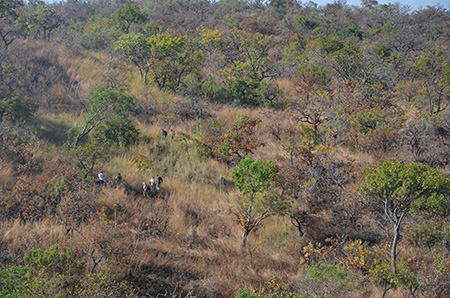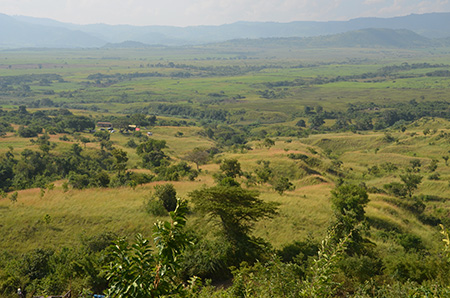An international team of scientists has documented the earliest evidence for local abundance in eastern Africa of the types of grasses that now dominate grassland and savannah ecosystems in tropical and subtropical regions around the world.
Africa’s iconic grasslands are dominated by plants known as “C4 grasses,” which use a photosynthetic pathway adapted for warm, arid conditions. The emergence of these ecosystems is important for understanding the evolution of early apes and other mammals.
“This new study puts C4 grasses on the landscape more than 10 million years before these grasses came to dominate the landscapes where we see them today,” said Pratigya Polissar, associate professor of ocean sciences at UC Santa Cruz and a coauthor of the study, published April 13 in Science.
Researchers have often argued that during the early Miocene, between about 15 and 20 million years ago, equatorial Africa was covered by a semi-continuous forest and that open habitats with C4 grasses didn't proliferate until about 8 to 10 million years ago. Yet there was some research indicating that C4 grasses were present in East Africa as early as 15 million years ago.
The new study sought to determine if this was an anomaly or a clue to the true diversity of ecosystems that occurred during the early Miocene. The findings would have important implications for understanding the features and adaptations of early apes and why there are tropical C4 grasslands and savanna ecosystems in Africa and around the world.
First author Daniel Peppe at Baylor University and an interdisciplinary team of scientists conducted research at nine Early Miocene fossil site complexes in the East African Rift of Kenya and Uganda as part of the Research on Eastern African Catarrhine and Hominoid Evolution (REACHE) project. The team focused on understanding the types of ecosystems that existed in the early Miocene, the prevalence of open environments and C4 grasses, and how these different environments could have potentially affected the evolution of early apes.
Polissar conducted isotopic analysis of fossil soils, focusing on molecular biomarkers from the plants that lived on those soils. “Our carbon isotope analysis of those soils provides unambiguous evidence for grasses with the C4 pathway living in these ancient environments,” he said. “This is a huge project and there were many other analyses that contributed to the overall findings as well.”
As participants exchanged information and expertise about geological features, isotopes, and plant and ape fossils found at the sites, the bigger picture came into focus. The paradigm that during the early Miocene period equatorial Africa was completely forested was wrong.
Further, the result of this decade-long research pushes back the oldest evidence of habitats dominated by C4 grasses—in Africa and globally—by more than 10 million years, calling for revised paleoecological interpretations of mammalian evolution.
“We suspected that we would find C4 plants at some sites, but we didn't expect to find them at as many sites as we did, and in such high abundance,” Peppe said. “Multiple lines of evidence show that C4 grasses and open habitats were important parts of the early Miocene landscape and that early apes lived in a wide variety of habitats, ranging from closed canopy forests to open habitats like scrublands and wooded grasslands with C4 grasses. It really changes our understanding of what ecosystems looked like when the modern African plant and animal community was evolving.”
The research flourished through the uniqueness of the REACHE project, according to coauthor Kieran McNulty at the University of Minnesota, who played a central role in organizing the project.
“Working in the fossil record is challenging. We discover hints and clues about past life and need to figure out how to assemble and interpret them across space and time. Any one of the analyses in these papers would have made for an interesting study, and any one of them, alone, would have produced incomplete, inconclusive, or incorrect interpretations,” McNulty said. “That is the nature of paleontological research: it’s like putting together a 4D puzzle, but where each team member can only see some of the pieces. By combining these methods, we leverage the strength of one to shore up weaknesses or validate assumptions of another, resulting in a synthetic approach that challenges well-established theories.”
The team combined many different lines of evidence—from geology, fossil soils, isotopes, and phytoliths (plant silica microfossils)—to reach their conclusions.
“The history of grassland ecosystems in Africa prior to 10 million years had remained a mystery, in part because there were so few plant fossils, so it was exciting when it became clear that we had phytolith assemblages to add to the other lines of evidence,” said coauthor Caroline Strömberg at the University of Washington. “What we found was thrilling, and very different from what was the accepted story. We used to think tropical, C4-dominated grasslands only appeared in the last 8 million years or so, depending on the continent. Instead, both phytolith data and isotopic data showed that C4-dominated grassy environments appeared over 10 million years earlier, in the early Miocene in eastern Africa.”
This much earlier occurrence of C4 grasses and open habitats found at the same sites as early apes also allowed the researchers to assess the kinds of environments in which the early apes were living. One of the most advanced early apes, Morotopithecus, was found to inhabit open woodland environments with abundant grasses and to rely on leaves as an important component of its diet. This contradicts long-standing predictions that the unique features of apes, such as an upright torso, originated in forested environments to enable access to fruit resources. These findings are transformative, said Robin Bernstein, program director for biological anthropology at the U.S. National Science Foundation.
“For the first time, by combining diverse lines of evidence, this collaborative research team tied specific aspects of early ape anatomy to nuanced environmental changes in their habitat in eastern Africa, now revealed as more open and less forested than previously thought. The effort outlines a new framework for future studies regarding ape evolutionary origins,” Bernstein said.
The research team includes Daniel J. Peppe, Susanne M. Cote, Alan L. Deino, David L. Fox, John D. Kingston, Rahab N. Kinyanjui, William E. Lukens, Laura M. MacLatchy, Alice Novello, Caroline A.E. Strömberg, Steven G. Driese, Nicole D. Garrett, Kayla R. Hillis, Bonnie F. Jacobs, Kirsten E.H. Jenkins, Robert Kityo, Thomas Lehmann, Fredrick K. Manthi, Emma N. Mbua, Lauren A. Michel, Ellen R. Miller, Amon A.T. Mugume, Samuel N. Muteti, Isaiah O. Nengo, Kennedy O. Oginga, Samuel R. Phelps, Pratigya Polissar, James B. Rossie, Nancy J. Stevens, Kevin T. Uno, and Kieran P. McNulty.
This work was funded by the National Science Foundation.





